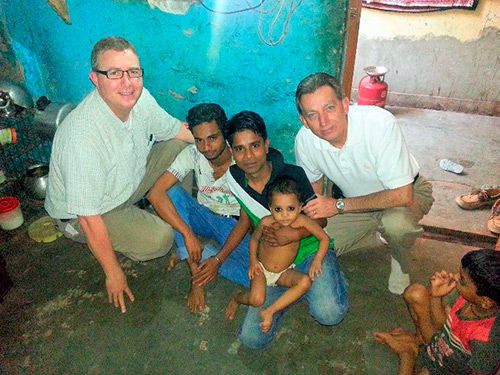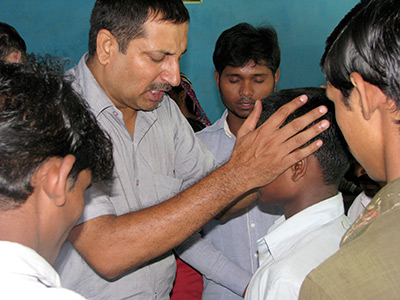You can throw a dart at a map of northern India, and you’re guaranteed to hit a place where unreached people groups live.
 Tim Rice and Ted Hodges, director of missions for the Chester Association, visit with Aslam Raju and his family, who live in an area of Delhi where they want to start a new church.
Tim Rice and Ted Hodges, director of missions for the Chester Association, visit with Aslam Raju and his family, who live in an area of Delhi where they want to start a new church.Or you can go to Delhi for nine days and be guaranteed to have multiple opportunities to share and pray with people, as a team of six South Carolina Baptists recently discovered.
“One day in our morning training, someone asked, ‘Where is the most unreached part of the world?,’ ” said Tim Rice, director of missions mobilization for the state convention. “The answer was, ‘You’re sitting in it.’ “
The Delhi metropolis has a population of 17 million, and that mass of people observes a plethora of religions: Hinduism, Islam, Sikhism, Baha’i, Christianity, Buddhism and Jainism.
“It’s just overwhelming how religion pervades absolutely everything about Delhi,” said Robert*, of New Hope Baptist Church in Pelzer. “There are all these gods, all these options, very religious.”
The ubiquitous nature of so many gods – idols of all forms and sizes that adorn every home, business, street corner, and public space – is in fact what International Mission Board personnel encourage volunteers to use as their launching pad for evangelistic conversations.
Skip Owens, from Charleston, recalled the irony of such an approach at a coffee shop he and his partner visited. “Here I was wanting to share with this young man sitting there, and I’m looking all around for a ‘god’ to get the conversation started, and I can’t find one anywhere!”
Owens and his partner ended up getting into a lengthy philosophical discussion about religion with the knowledgeable young man, and Owens shared the gospel with him.
Said Naveen Balakrishnan, a native of southern India, “Indians want to hear a good story. They will give you countless hours for a story, and people will gather to hear what you’re sharing.”
That was the consistent experience of the team: a conversation with one or two people morphing organically into a gathering of 10 to 100 people.
A clinic doctor in one village invited two team members to his home. There they prayed for his feverish daughter, told Bible stories and shared their testimonies, and returned the next day to find the daughter well, and 100-plus people gathered to hear more Bible stories.
“This doctor told us they’d been discussing us after we left, whether we were good or bad,” said Robert. “Before we left, he asked us for material to leave with him so he could teach it to the rest of the village. He wanted to share our Bible stories – and he wasn’t even a believer.”
Furthermore, as it turned out, one of the national pastors had just moved into an apartment complex next to the same village.
“Only the Lord could arrange such things,” concludes Larry*, of Hillcrest Baptist Church, Williamston.
 Deep passion for prayer and worship characterized the house churches that the South Carolina team visited in Delhi.
Deep passion for prayer and worship characterized the house churches that the South Carolina team visited in Delhi.It was one of many examples of the team finding the “person of peace” that Jesus taught about in Luke 10. Team members were instructed to spend their afternoons prayerwalking, sharing specific Bible stories and their testimonies, and seeking out such “persons of peace” who would invite them into their homes and introduce them – and their accompanying national pastor or church planter – to others in the village or neighborhood.
As Owens and Balakrishnan walked along a boardwalk over a stream of raw sewage in the middle of an outlying village, they saw an older man leaning against a tree that was growing up in the stream. They approached him and asked if they could pray for him and tell him a story. He agreed and motioned some passersby to fetch chairs for the small crowd that began to gather.
From that encounter – and the subsequent invitations – grew a two-day adventure that included multiple decisions and another healing of a girl with a fever. The girl’s mother said to Owens and Balakrishnan, “Now that your Jesus has healed my daughter, does this mean I must get rid of all my [Hindu] gods and follow only Jesus?”
“She had not received Christ,” said Balakrishnan, “and no one had explained to her that the call of Jesus is to forsake all other gods, but she got it anyway; she understood what this healing and her daughter’s decision to accept Christ meant.”
While the South Carolina Baptist Convention mission partnership with South Asia was formally completed in 2009, Rice said state Baptists wanted to stay active and engaged in the area. The September visit was the second such “discovery trip” of the year. The six-member team completed Embrace 201 training offered by IMB personnel and developed to help churches interested in working among unreached people groups. Three such trainings are scheduled for next year in India.
“The purpose was to get our pastors to meet national pastors and church planters, to work with them to start new churches, disciple people, encourage and pray for believers, and prayerwalk,” he said.
One of the Indian pastors with whom the team served had come to the city penniless but passionate for evangelism and church planting, and has now started 38 churches in Delhi and 85 churches outside of it. In all but five churches, he has turned over the leadership to disciples he’s trained. He draws no salary from any of those churches, relying month-to-month on believers to support him.
“Their philosophy is, ‘People shouldn’t have to come far to go to church. Let’s start something there,’ ” Robert said. “And they say that even when there’s a church within five miles of a village.” – SCBC
(*Some missions volunteers described in this story may return to India in the future. Their last names are being withheld for security purposes.)